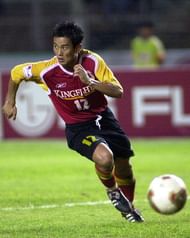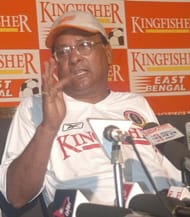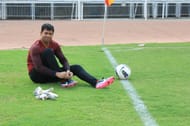The 10th anniversary of East Bengal’s ASEAN Cup triumph in Jakarta brings back a host of memories. East Bengal scripted history on Saturday, July 26, 2003 when they became the first Indian club to win any officially recognised international football tournament by demolishing Thailand’s BEC Tero Sasana 3-1 in the LG ASEAN Cup final.
It was heralded as a major triumph as BEC Tero were finalists in the inaugural (2002-03) AFC Champions League and had defeated East Bengal 1-0 in this tournament’s first league match. The Geloran Senayan stadium was again a happy hunting ground for Indian football. At this same venue, India had won the 1962 Jakarta Asian Games gold medal, beating South Korea 2-1 in the final.
The 2003-04 season was the best of times and most frustrating of times for East Bengal. The season started with a flourish when East Bengal won the LG ASEAN Cup in July, displaying captivating, free-flowing football. They were a well organised team, with adequate bench strength.
But on their return to India there was an inexplicable slump, which is still difficult to explain. Oozing with confidence, this star-studded Kolkata team was expected to dominate national domestic tournaments. However in the next few months from August to November, they underperformed in three tournaments on the trot.
In the Federation Cup quarterfinals, Vasco (Goa) upset them 1-0, with an 85th minute goal by Sushant Mathews. Another Goan club Salgaocar proved to be their nemesis in the Durand final. In the IFA Shield final, they lost on penalties to rivals Mohun Bagan.
The way in which East Bengal had won the 2003 LG ASEAN Cup tournament, nobody predicted their sudden slump. In the Jakarta final, East Bengal’s goal scorers were Mike Okoro at the half hour mark, Bhaichung Bhutia 49th minute and Alvito D’Cunha, 69th minute.
Alvito’s stunning goal with his weaker foot a rasping, low right footer was the turning point in the match. Till then BEC Tero Sasana had piled on the pressure and mid-fielder Panai Kangapan had reduced the margin in the 55th minute. However Alvito’s wonder strike left BEC Taro Sasana subdued.
East Bengal’s team in the final (3-5-2 formation): Sandip Nandy, Sur Kumar Singh, M. Suresh, Deepak Mondal (S. Malsawmtulunga), Suley Musah (Captain), Sasthi Duley, Bijen Singh, Douglas D’Silva, Alvito D’Cunha, Bhaichung Bhutia and Mike Okoro.
Kingfisher East Bengal received $50,000 for their success in the ASEAN Club championships.
On their way to the ASEAN Club Cup title East Bengal had trashed Armed Forces F.C. Philippines 6-0 (Bhaichung scored all six goals, the first Indian to achieve a double hat-trick in international football). They next beat Indonesia’s top two clubs Persita Tangerang 2-1 in the quarterfinal and Petrokimia Putra (1-1) and 7-6 in sudden death penalties in the semi-final.
Many positives emerged from these victories. The ASEAN Cup triumph had a double benefit for football in India. It revived the mass hysteria in Kolkata for football (about 15,000 delirious East Bengal fans gathered at the international airport to welcome their team’s return from Jakarta) and foreign clubs sought Indian players.
Baichung Bhutia went on loan for two months (August 15 – October 15) to Malaysian league champions Perek F.C. Besides paying Bhaichung, the Malaysian club also gave East Bengal $10,000 as compensation.
Thailand league champions BEC Tero Sassana tried to procure the services of young defender Sur Kumar Singh and striker Mike Okoro. Mahesh Gawli, M. Suresh and goalkeeper Sandip Nandy were snapped up next season by Mahindra United on lucrative salaries. Thus East Bengal’s 2003 ASEAN Cup triumph heralded the start of big money transfers in Indian football.
Subash Bhowmick’s meticulous planning and vision helped East Bengal win the 2003 ASEAN Cup. The club officials allowed their coach a free hand in selection of players to strengthen the squad. Internationals, Bhaichung Bhutia, Mahesh Gawli, Debjit Ghosh, Sur Kumar Singh, Bijen Singh and Raman Vijayan were recruited at the start of the season. Most of the previous year’s squad, which had won five major tournaments including National Football League (NFL) and Durand Cup, were retained.
Like professional clubs in Europe/Japan/S.Korea, East Bengal emphasised on pre-season training to improve fitness levels. The players stayed in a five-star hotel, with access to a gymnasium and sauna baths for six weeks. The rigorous training by the South African trainer Kevin Jackson made the 2003 East Bengal squad the fittest ever football team in India.

Bhaicung Bhutia of Kingfisher East Bengal, India, in action during the final in Jakarta 26 July 2003. (Getty Images)
It was Bhowmick who persuaded sponsor (Kingfisher) Vijay Mallaya to substantially increase the annual sponsorship. This extra money helped to pay Jackson his fees of $1,000 per week and gave the players improved facilities. The idea of a physical trainer occurred to Bhowmick when he saw the improved fitness of the Indian cricket team, especially that of skipper Saurav Ganguly. The national cricket team then had a South African trainer, Andrew Leipus and he recommended Kevin Jackson to Bhowmick.
Under Jackson’s guidance East Bengal’s approach and preparations for the 2003-04 season had been the best ever by an Indian club side. They set a trend and soon other clubs including rivals Mohun Bagan invested in physical trainers and high quality facilities. Every club in the I-League has since emulated East Bengal and hired specialised physical trainers. So Bhowmick was quite clairvoyant in hiring Kevin Jackson.
So what went wrong for the next six months with this star-studded team? A combination of factors led to dismal results. The Federation Cup was held in the monsoon months in Kolkata that year. The matches in August were played on slushy, muddy surfaces on which buffaloes would fear to tread.
Bhowmick felt that his team of superstars could suffer injuries and it was not possible to play attacking football on such surfaces. He requested the club management to skip this tournament or at most field a second string team. They did not agree.
In their opening encounter, East Bengal routed HAL Bangalore 5-0 but then succumbed to an ultra defensive Vasco 0-1. Vasco scored in one of their rare counter attacks and East Bengal despite playing with four forwards in the closing minutes could not equalise. It was an upset of a huge magnitude. The recent ASEN Cup champions being humbled by a not very strong club from Goa, was like Senegal beating holders France 1-0 in their opening match of the 2002 World Cup.
Acrimony between Bhowmick and the club management increased after this tournament. Next up was the IFA Shield in September 2003. In the second semi-final on Sept. 26, their midfield kingpin the Brazilian Douglas D’Silva got a second yellow card and was ruled out for the final. Without Douglas East Bengal stumbled against arch-rivals Mohun Bagan. The match ended in a goalless draw but Bagan won the penalty shoot-out 5-3 with Prasanta Dora saving M. Suresh’s angled penalty kick.
In early November 2003, East Bengal reached the Durand final. The closely fought battle with Salgaocar ended in a 1-1 draw. Again East Bengal faltered in the penalty shoot -out with ace striker Mike Okoro squandering his kick. Salgaocar won on penalties 4-3 and overall 5-4.
Again Bhowmick and his team were not very willing to play in India’s oldest tournament. Bhowmick wanted the club management to expand their horizons and compete in international tournaments in Asia. After their ASEAN Cup success East Bengal received several invitations to participate but declined them because of domestic commitments. Bhowmick’s ideas were laudable but the club management remained conservative.
The only domestic title East Bengal won in 2003 was the Kolkata league. The play-off final with Mohun Bagan on November 2, ended in a 1-1 draw. The teams were tied 3-3 in the penalty shoot-out. However East Bengal prevailed 2-1 in the sudden death.
Injuries and complacency affected East Bengal at the start of their 8th ONGC NFL campaign. They procured just two points from their first three matches, losing to Salgaocar and drawing with Vasco and JCT Mills, Phagwara. Their first win came in the fourth round, an injury-time goal by Baichung enabled them pip Churchill Brothers 2-1.
But then Bhowmick played a master-stroke. With Mike Okoro injury-prone, he bought another classy foreign striker, the Brazilian Cristiano Junior. The late Cristiano gelled perfectly with Baichung and East Bengal once again discovered their Midas touch. They became the first club to win back-to-back national football league titles. They won the twelve team league convincingly finishing four points ahead of runners-up Dempo.
In early 2004, East Bengal again continued their domination of South East Asian clubs. They beat Geylang United (Singapore), Negri Sembilan (Malayasia) and Island FC Maldives to comfortably qualify for the quarter finals of the inaugural AFC Cup.
So for East Bengal the 2003-04 started with a flourish and ended with bang, despite several hiccups on the way. I had the privilege of doing commentary of East Bengal’s matches in the ASEAN Cup and the quality of football they displayed in the final has remained unsurpassed. For many of us it seemed that Indian football had at last got over the hump. But it was yet another false dawn. The quality of football produced by East Bengal in July 2003 at the ASEAN Cup now seems like a midsummer night’s dream long, long ago.


